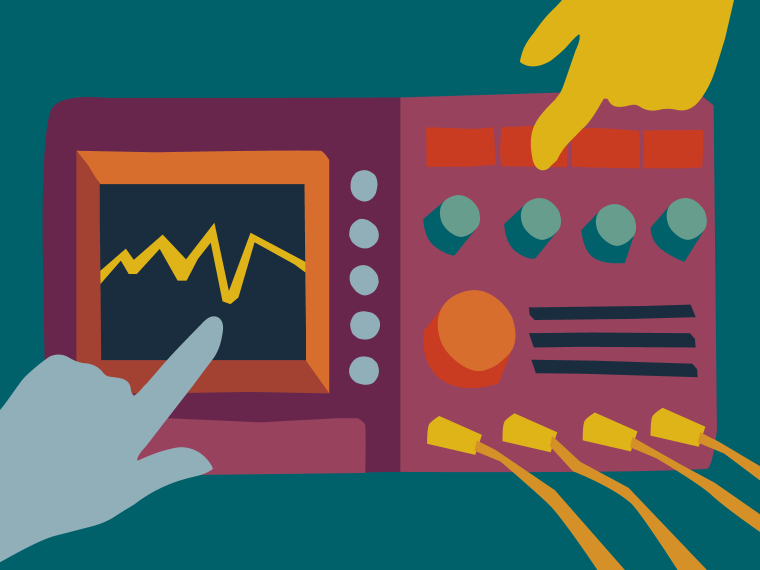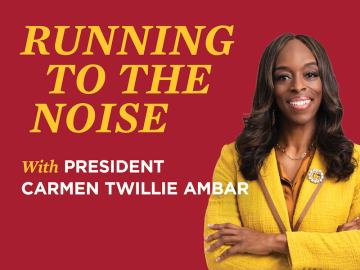“Searching for Dark Matter (From Oberlin)”
July 3, 2019
Communications Staff

Physics students Sunyool Park ’19 and Dhruv Tandon ’22 are looking for ultralight axion-light particles, which are candidates for dark matter.
Park and Tandon take a break from searching for dark matter to share their excitement with us and let us in on their research process.
Listen to the episode:
Accessible Transcript
This episode is narrated by Erin Ulrich, and features an interview with Sunyool Park ’19 and Dhruv Tandon ’22. Associate Professor of Physics Jason Stalnaker is also featured.
[Theme music playing in background]
Erin: “This is An Oberlin Minute, an audio series dedicated to highlighting the inspiring work of Oberlin students, faculty and staff. We’ll be getting an inside look at the pulse of Oberlin by exploring research, performances, and everything in between.”
[Background noises, voices of students working in the lab]
Erin: “We’re going to be hearing from two student researchers in Associate Professor of Physics Jason Stalnaker’s lab over winter term whose research involves looking for ultralight axion-like particles that are candidates for dark matter and get a closer look at the inner workings of the lab.”
Dhruv: “So, my name is Dhruv. I’m a first-year. I’m a physics major. I will be a physics major. It was really generous of Jason to allow me to work in this lab. I’m from India and I didn’t want to go home for just a month and I wanted to explore things and then I just emailed Jason and he was like yeah sure, come and we can talk about it, yes. He said yeah, you should come to my lab and then you will learn during the process.”
Sun: “I’m Sun, I’m class of 2019, so I’m a senior now. I actually got involved with Jason’s lab during a winter term my second year.”
Sun: “We’re part of this collaboration which is called GNOME, the Global Network of Optical Magnetometers to search for Exotic Physics and we’re specifically looking for ultralight axion-like particles which are a candidate for dark matter. So, the idea is that these particles would interact with spins of elementary particles—ultralight axion-like particles. When they do interact, we would be able to detect it with a magnetometer. A magnetometer is an instrument that measures magnetic fields. So, we have multiple magnetometers throughout the world. All of our data are uploaded to a server and they are all GPS time-stamped, which means we would know exactly when an event happened, so we can also study the correlations of the signals at multiple locations throughout the world and then that would allow us to say more about the particles. Even if we don’t see anything, we can start constraining the model. We are working towards building a more sensitive magnetometer.” [Laughter]
Sun: “Sorry, was that simple enough?”
Erin: “Perfect. [Laughter]
Dhruv: “It was really simple. [Laughter]”
Erin: “For you personally, what’s the most exciting part of doing physics research?”
Sun: “Doing research for winter term is really great because during the semester, if you are doing research, you maybe go in once or twice a week for a very limited amount of time because you have school. So, you do things, but it’s not as fast as it could be. So, during winter term, you basically work all day in research, you see progress, because it’s going really fast. And I really enjoy that and I really enjoy the fact that I can really get involved in the experiment.”
Dhruv: “As a first-year, I had no experience about research, so I was...really nervous when Jason said I can do it. But it’s been really good learning new things every day and just to know there are a lot of things in the research that even the professor don’t even know and that makes it really exciting for me. There are so many things that we don’t know about and I don’t know...as a first-year, I just learn so many things every day, which are sometimes they are simple and sometimes they are really complex—I don’t get anything—but it’s just fun for me.”
Erin: “Can you sort of walk me through just a typical day in the lab during winter term?”
Sun: “I would get to Wright, the physics building around nine and I enjoy a cup of coffee, because I need coffee. [Laughter] Sometimes we would all as a research team talk about plans for the day or for the week...then we come up with a plan for the rest of the day and we go into the lab and we do the experiment.”
Erin: “So, you are pretty much working and doing research the entire day?”
Sun: “Yes.”
Erin: “In addition to working in the lab, Dhruv and Sun regularly check in with the GNOME collaboration, which includes partners in North America, Europe, China, and Korea.”
Sun: “So, we have Skype meetings twice a week and then one is with the whole collaboration around the world. The other one is just with the people in these States.”
Sun: “So right now, that is where the beam is.”
Erin: “Sun and Dhruv also shared with us how their research relates to their academic and postgraduate plans, as well as the most impactful parts of participating in this research. “
Dhruv: “Working in the lab and keep learning more stuff like that...”
Sun: “I think I have always had an idea that I want to go to grad school after college and I knew that I really liked physics, so I wanted to do something physics-related. Having this experience in his lab sort of guided me to want to pursue a PhD or even a career in atomic physics, so I recently have applied to a bunch of PhD programs in atomic physics.”
Erin: “What’s been really the most impactful part of being able to do this, to sort of pursue what you would maybe want to do after you graduate for a career and explore different projects outside of the classroom?”
Dhruv: “So, as I said earlier, this is my first winter term. It helped me a lot to form ideas about what actually research looked like, because in the classes and from my high school, I thought...I had no idea what research is like and what people do in lab. Working in this lab, I realized what actually goes on in the lab and how people work in it...I don’t know, it shaped my perspective about research. It motivated me to keep doing research in future years.”
Sun: “You can see where the beam is. It’s a little bit too high right now...”
Erin: “To learn more about what takes place at Oberlin, visit www.oberlin.edu/news. A big thank you to our student workers. The audio for this episode was engineered by Sarah Goodstein, Piper Hill and Molly Thayer.”
[Theme music plays in background]
Erin: “Interviews were conducted by Erin Ulrich and sound design and theme music were composed by Piper Hill and Claudia Hinsdale. Our graphic designer is Andrea Wang, and this episode was coproduced by Yvonne Gay and Erin Ulrich in the Office of Communications. Special thanks to our consultant and Oberlin’s digital media engineer, Kyle Hartzell. This has been An Oberlin Minute. Thanks for listening.”
Tags:
You may also like…
Carmen Twillie Ambar Hosts New Podcast
September 27, 2023
“Oberlin Opera Theater and the American Dream”
July 8, 2019
“From the Classroom to the Boardroom”
June 27, 2019


